Have you ever dreamed of seeing manta rays in the Maldives like me? Many divers and snorkelers have! But do you know when is the best time to see manta rays in Maldives? Which atoll has the highest population of these gentle creatures in each season? Due to changing monsoons and numerous manta points, it might be challenging for you to plan your adventure. But no worries! In this post, I’ll share all the insider tips about when and where to spot manta rays in Maldives.
With 35000 square miles of warm turquoise waters, 1,192 palm fringed islands, and white-sandy beaches, Maldives provides a once in a lifetime opportunity to see manta rays in their natural habitat.
Seeing manta rays in the Maldives has always been on my Maldives bucket list. I recently had the chance to fulfill this long-time dream, and it was truly an unforgettable experience. Here are the 10 best places to see manta rays in the Maldives. So, without any further ado, let’s begin!
Curate and plan your Maldives Tours
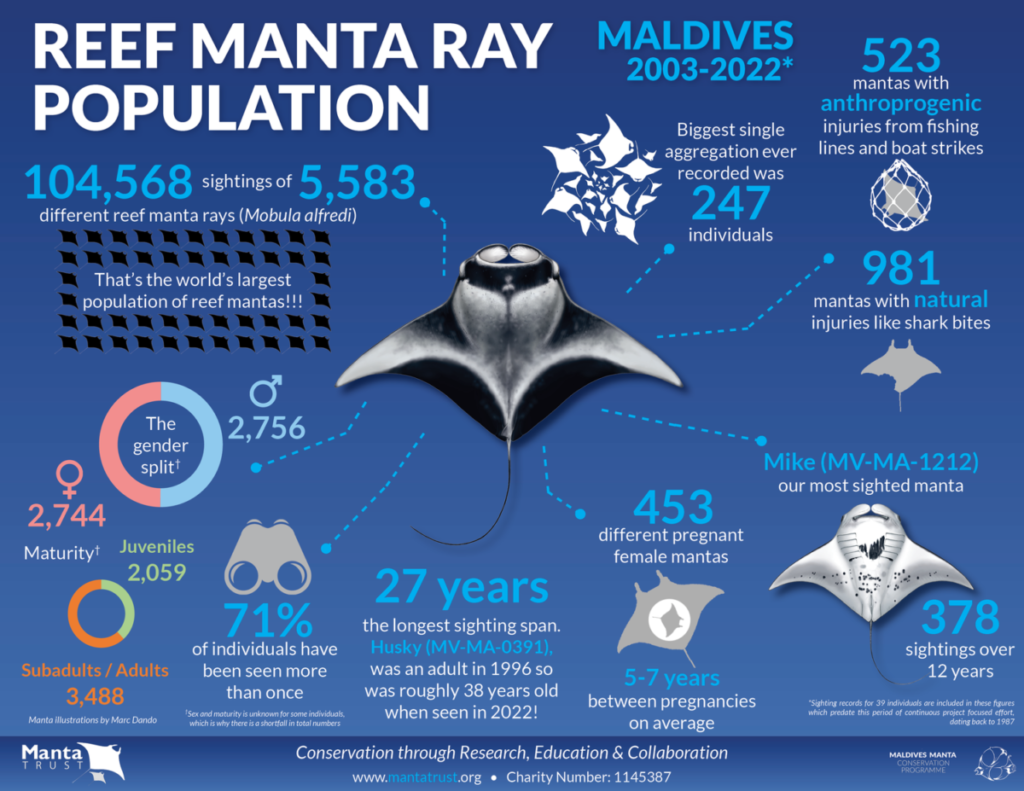
Key Takeaways
- Addu Atoll: Provides year-round diving opportunities with manta rays and the largest shipwreck in Maldives, British Loyalty.
- Baa Atoll: Hanifaru Bay is the largest manta ray congregation in the Maldives and is part of the UNESCO World Biosphere Reserve.
- South Ari Atoll: Get up close with Manta Rays at Moofushi, Madivaru, and Dhigurah Etere from November to March.
- North Ari Atoll: A pelagic dream destination. Experience the night diving with manta rays at Fesdu Lagoon.
- South Male Atoll: Popular for underwater formations, like caves, thilas, and kandus. Dive with manta rays at Cocoa Thila, one of the best diving sites in the Maldives.
- North Male Atoll: Famous Maldivian atoll for observing manta rays at Manta Point.
- Lhaviyani Atoll: Observe reef manta rays in its sparkling turquoise waters from October to February
- Raa Atoll: Best for incredible encounters with manta rays, along with calm lagoons and pristine beaches.
- Laamu Atoll: A peaceful Maldivian paradise with a large population of reef manta rays year-round.
- Fuvahmulah Atoll: Known as Galapogas of Maldives, this isolated atoll is home to the oceanic manta rays.
Manta Rays in Maldives: A Quick Overview
Before going into the best places to see manta rays in Maldives, let’s see what makes Maldives a popular place to see or dive with manta rays!
Maldives, located southwest of Sri Lanka in the Indian Ocean, has the largest population of manta rays in the world. Two types of manta rays are commonly found in Maldives: reef manta rays (Mobula alfredi) and oceanic manta rays (Mobula Birostris).
The Maldives Manta Conservation Program (MMCP) collects data about the manta ray population in the country, tracks their movements, and the impact of tourism and the environment on them. The project has identified over 5,500 different reef manta rays and over 850 different oceanic manta rays. Most oceanic manta rays are reported in the Fuvahmulah Atoll (discussed below).
This Indian Ocean archipelago comprises 26 natural coral islands known as atolls. These atolls are popular for their colorful reefs and strong ocean currents. Manta rays move across these atolls, following the change in concentration of plankton blooms.
Manta rays serve as an important economic resource for the Maldives, attracting more than 10,000 visitors each year. Several certified tour operators in the Maldives offer snorkeling and diving tours to see mantas. You might encounter these majestic creatures while swimming or diving if you’re lucky.
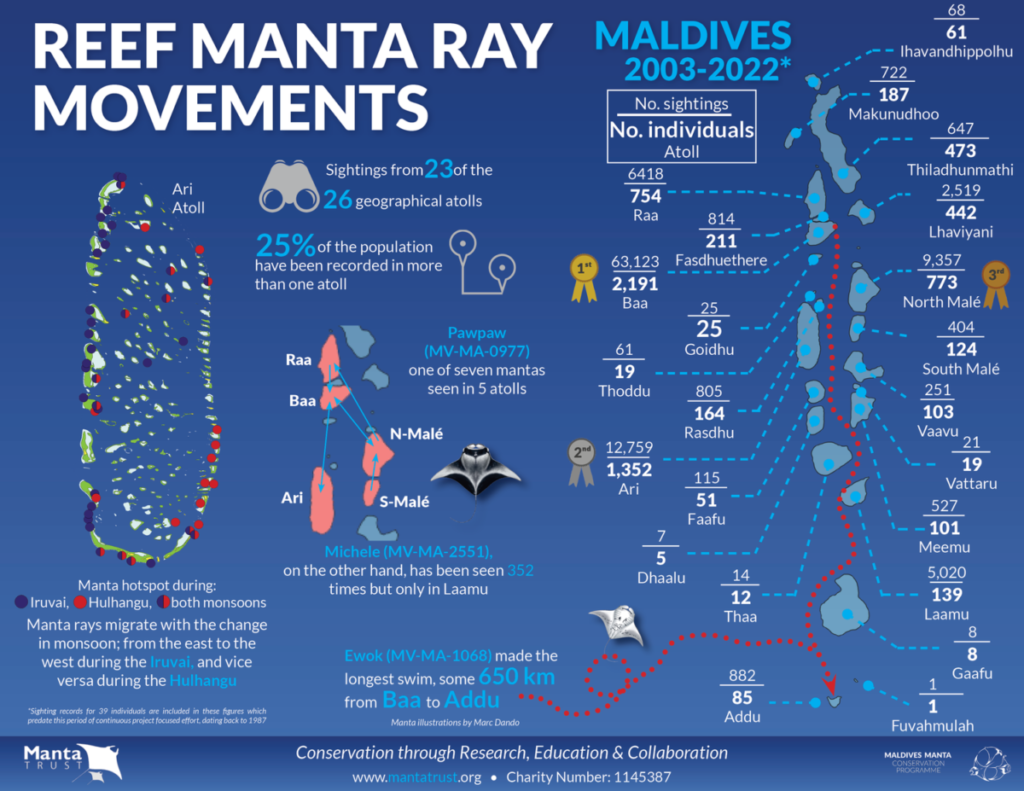
When to See Manta Rays in Maldives?
The Maldives experiences two monsoons each year: the Southwest Monsoon (May to November), or wet season, and the Northeast Monsoon (December to April), or dry season. The monsoon seasons greatly influence the migration and feeding behavior of manta rays.
During the southwest monsoon, mantas move to the eastern shores of the atolls, following plankton. During the northeast monsoon, mantas migrate to the western edges of the atolls.
Although manta rays are present year round in the Maldives, the peak sighting season is southwest monsoon, from June to November. We all know nature is unpredictable, but following this weather pattern can increase your chances of spotting manta rays in Maldives.

Best Places to See Manta Rays in Maldives
where to see manta rays in Maldives?
Here are the 10 must visit atolls to spot amazing marine creatures and manta rays in Maldives.
1. Addu Atoll
The heart-shaped Addu Atoll, also known as Seenu Atoll, is the southernmost atoll in the Maldives. Its reefs are teeming with marine life, including manta rays and other pelagic fish like sharks and eagle rays.
The atoll has sandbars, four inhabited islands, 20 deserted islands, and a lagoon. Its underwater landscapes, such as thilas, deep channels, and coral reefs, attract a large population of Reef Manta Rays, which can be seen all year round.
The atoll topography makes it a perfect diving destination in the Maldives. Although the Addu cleaning station, around 25 m deep, isn’t an easy dive. If you’re a beginner opennwater diver, I’ll advise you not to try it. However, if you’re snorkeling, you must be very lucky as there are rare chances of seeing manta rays.
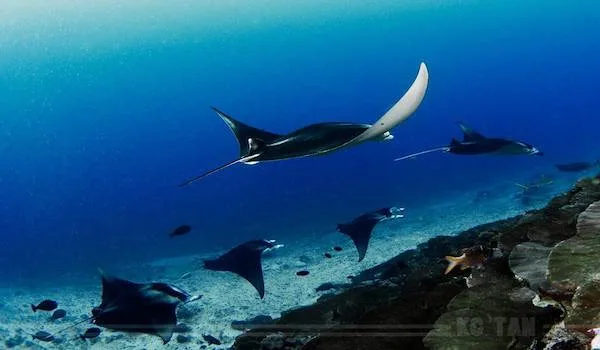
Best Time to See Manta Rays in Addu Atoll
Addu Atoll enjoys a hot and humid tropical climate throughout the year, and water temperatures range from 27 to 31 degrees Celsius. The atoll’s warm waters make it a year round location where manta rays can be seen in the Maldives. Visibility can range from 2 to 20 meters. The best time to see manta rays in Addu Atoll is from December to April, when visibility might reach 30 meters.
Best Manta Ray Hotspots in Addu Atoll
Muli Kolhu Faru
Located in Viligilli Kandu, Muli Kohlu Faru is a yearn round site for manta ray sightings. Divers can see manta rays, up to 4 meters wide, near the wreckage of a WWI anti-submarine boom.
Maakandu Channel
A spectacular diving destination in Addu Atoll. If you love diving in strong ocean currents, this channel is a must visit. Around the reef’s corner, you’ll spot reef manta rays.
Maa Kandu Beyru
This best diving site for beginners offers a gentle drift dive around the outer reef. At its beautiful coral formations, you can see manta rays, eagle rays, and turtles.
British Loyalty Shipwreck
This shipwreck is the most popular diving site in Addu Atoll. This 5,583-tonne oil tanker was made in 1928 and sank during WWII in March 1944. The wreck lies around 108 feet underwater and is covered with soft and hard corals. It is a year-round site where manta rays and sharks can be seen. It takes less than 25 minutes to reach here by boat.
Best Liveaboards Visiting Addu Atoll
Many liveaboard companies include Addu Atoll in their southern atoll tours in the Maldives. Some popular liveaboards in Addu Atoll are Emperor Leo, Carpe Diem, and Sucbaspa Yang.
Best Diving Resorts in Addu Atoll
When looking to stay near Addu Atoll, you’ll find hotels, resorts, and guesthouses on its inhabited islands. I’ll recommend Equator Village and Canareef Resort Maldives. Some resorts also have dive centers, like Aquaadventure PADI 5 Star Dive and Addu Dive.
How to Get to Addu Atoll
From Male International Airport, you can fly to Gan International Airport in Addu Atoll. In Addu, your resorts will arrange local transfers by boat or car.
2. Baa Atoll
Baa Atoll, located in the northern part of the Maldivian Archipelago, is a favorite destination for travelers who come to Maldives to see manta rays. This small atoll is rich in marine life, with beautiful soft corals at Maavaru Kandu and plenty of fish at Dhonfanu Thila. Its unique location next to a big channel and the shape of its main area, Hanifaru Bay, make it a perfect place for plankton to gather, attracting hundreds of reef manta rays.
Over 1600 mantas have been sighted at Baa Atoll, a big chunk of the Maldivian manta population. Together, these mantas create a beautiful sight: cyclone feeding. So, if you want to see manta rays in Maldives, Baa Atoll must be on your itinerary.
If you want an unforgettable snorkeling or scuba diving adventure in Baa Atoll, I highly recommend Dharavandhoo Divers. You won’t be disappointed!
Best Manta Ray Hotspots in Baa Atoll
Hanifaru Bay
The most popular spot to see manta rays in Maldives is Hanifaru Bay, the only UNESCO Biosphere Reserve in the Maldives. Its reef is funnel shaped, where a large population of reef manta rays and whale sharks gather. You can expect to see up to 200 manta rays at a time. During my visit, there were so many mantas that I lost count; it was an incredibly amazing sight!
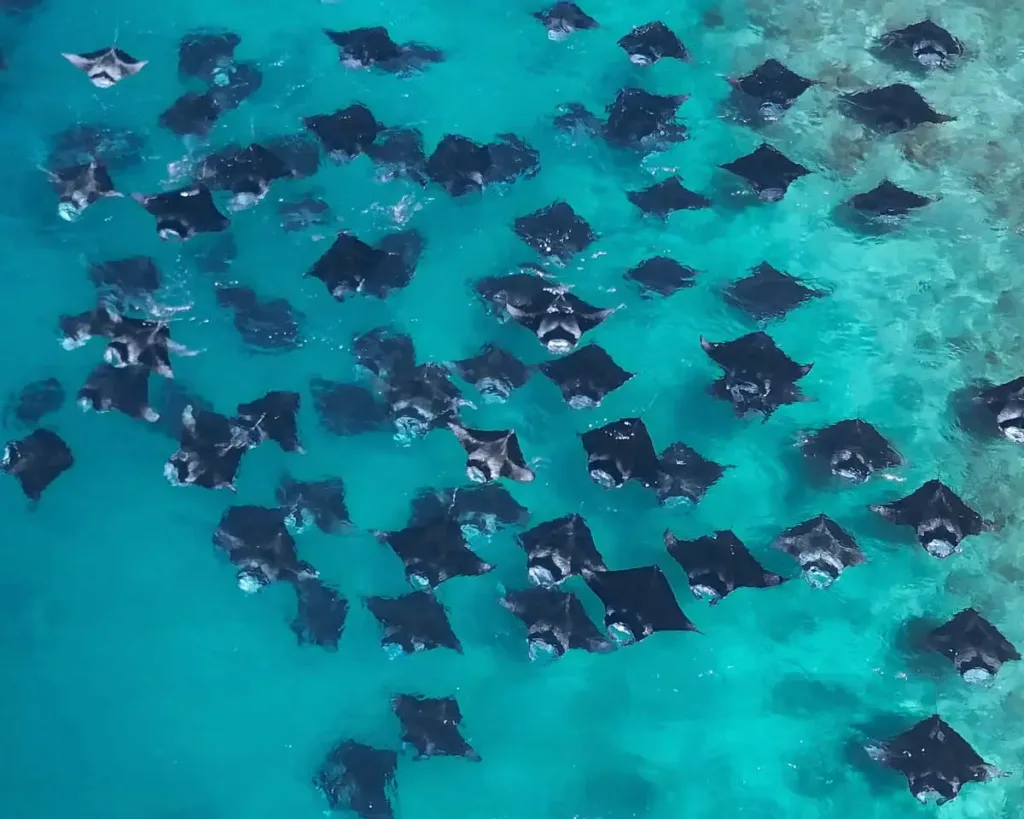
In 2009, the Maldivian Government declared Hanifaru Bay a Marine Protected Area (MPA) due to unsustainable tourism. The Manta Trust and the Ministry of Environment made many sustainable efforts, and in 2011, all of the Baa Atoll was designated a UNESCO World Biosphere Reserve. Hanifaru Bay is declared one of the most core protected areas. Diving is not allowed in the Hanifaru Bay. But snorkelers can swim with manta rays with a certified guide. Hanifru bay is the one of the best to swim with manta rays in Maldives.
Dharavandhoo Corner
This famous manta ray cleaning station is located near Hanifaru Bay. Some tour guides combine a snorkeling trip to the bay with a dive at Dharavandhoo Corner.
Horubadhoo Thila
Located in Baa Atoll, it is covered in hard and soft corals and is home to large pelagic species. Here, you can spot manta rays from May to November.
Dhonfanu Thila
This small thilla is a short swim from the main reef and has a narrow swim-through surrounded by beautiful black corals. Here, you can see manta rays regularly (during the season) and different colorful fish, such as red-toothed triggerfish, starry rabbitfish, and angelfish.
Manta Season in Baa Atoll
The best time to see manta rays in Hanifu Bay is from May to November, during the southwest monsoon. During the new or full moon, tidal currents bring a high concentration of plankton into the bay, which attracts hundreds of filter feeders, including manta rays and white sharks.
Best Diving Resorts to Stay in Baa Atoll
Baa Atoll has luxurious, private, and budget-friendly accommodations for all travelers. If you want to stay near Hanifaru Bay, Royal Island Resort, Dusit Thani, and Aveyla Manta Village are the popular options.
Best Liveaboards Visiting Baa Atoll
Most northern liveaboard tours go to Baa Atoll, particularly Hanifaru Bay, during manta season. If you’re tight on budget, you can go with Carpe Diem, and for a luxurious experience, choose Scubaspa Ying. These cruises have specific drop zones allowing divers to enter the water to see manta rays from a short distance (about 3 meters from the head and 4 m from the tail).
How to Get to Baa Atoll
From Male International Airport, you can take a 30-minute domestic flight to Dharavandhoo or a 40-minute seaplane transfer to the Baa Atoll. Most resorts in Baa Atoll include local transfers in your stay package.
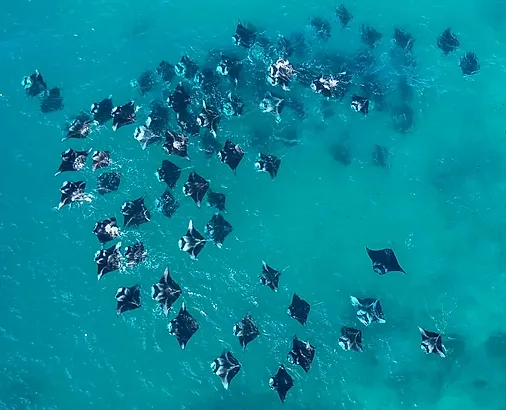
3. South Ari Atoll
South Ari Atoll, also known as Alifu Dhaal, is a popular tourist destination southwest of Male. If you love snorkelling, diving, and water sports, this atoll is a must-visit place. You are guaranteed to see manta rays and whale sharks here.
The main topography of the atoll is thilas and kandus. Kandus are channels filled with strong currents that connect the open ocean. Manta rays visit here to find food and clean jelly fish. Thilas, underwater mountains, are beautiful coral reefs that rise from the sea floor, attracting manta rays.
Even though the atoll is large, you can easily see its colorful reefs from any resort in South Ari. The atoll’s shallow and easily accessible dive sites make it one of the best Maldives manta ray locations for novice and experienced divers.
Manta Season in South Ari Atoll
Manta ray sightings are possible year round. However, the larger congregation of mantas occurs during the northeast monsoon season, from December to April.
Manta Ray Hotspots in South Ari Atoll
Rangali Madivaru
This popular diving site in South Ari Atoll is located on the south edge of Rangali Kandu and the west side of Maamigili Marine Protected Area. This large channel brings plankton rich water to the central lagoon, attracting a large population of reef manta rays (adults).

Moofushi Manta Point
This diving site is located on the eastern edge of a large plateau, surrounded by a big coral block underwater at a depth of 16 meters. During the northeast monsoon, manta rays visit this cleaning station.
Mahibadhoo Manta Point
Located on the eastern coast of South Ari Atoll, this thila is a channel between the open ocean and lagoon. The water moving through this channel creates a strong current that repeatedly attracts manta rays. If you dive there when the current is outgoing, you’ll see many mantas.
Best Diving Resorts in South Ari Atoll
Visitors can find a range of resorts in the atoll, especially on the outer islands of the reef. These resorts provide easy access to all diving sites in South Ari Atoll. Popular options include Lily Beach Resort, LUX South Ari Atoll, and Constance Moofushi Maldives.
Best Liveaboards Visiting South Ari Atoll
Many liveaboards visit South Ari Atoll during their central atoll itineraries due to its shallow and easy to dive sites. Most trips depart from Male, like Scubaspa Yang, but some liveaboards start from Baa Atoll, like Carpe Diem.
How to Get to North Atoll
South Ari Atoll is around 100 km southwest of Male. From Male, visitors can take a 20-minute domestic flight or a 30 minute seaplane to your resort.
4. North Ari Atoll
North Ari Atoll, also known as Alifu Alifu Atoll, is among the best places to see manta rays in the Maldives. The atoll is home to 70 tropical islands, ridges, resorts, and easily accessible dive sites. Its undersurface landscapes, which include reefs, wrecks, thilas, and channels with strong currents, attract marine creatures. Manta rays, eagle rays, gray reef sharks, whale sharks, and turtles are popular sightings.
North Ari Atoll has 23 diving sites, including Maaya, Hafza, Maalhos Thilas, and Fish Head. This narrow atoll allows visitors from all resorts to access these dive sites. Due to strong ocean currents, most diving sites are only for experienced divers.
Manta Season in North Ari Atoll
The tropical climate makes North Ari Atoll a year-round destination for diving and snorkeling. The best time to spot manta rays is during the southwest monsoon, from May to November. However, at some sites, like Himadhoo Dhonkalo Thila, you can see manta rays during the northeast monsoon.
Best Manta Ray Spots in North Ari Atoll
Fesdu Lagoon
The lagoon provides the opportunity to see manta rays at night. Divers sit on the sand and use lights to attract plankton. Soon, you’ll see manta rays coming and display their rare cyclone-feeding behavior under the lights.
Ukulhas Thila
A popular site where you can see dozens of manta rays from August to November.
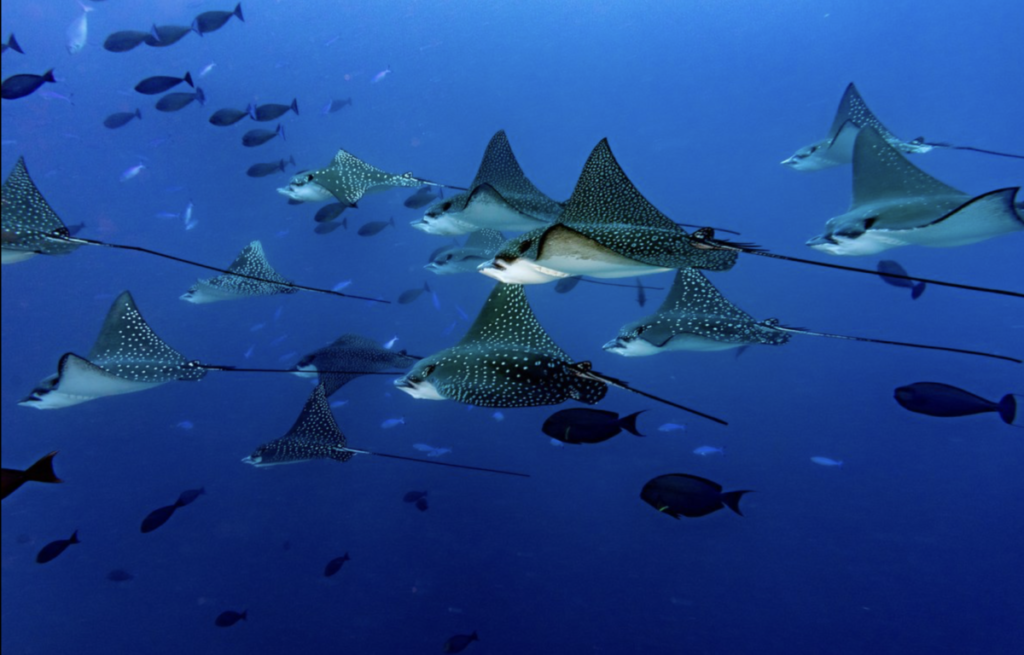
Best Diving Resorts in North Ari Atoll
North Ari has many accommodation options, including guesthouses, resorts, and private luxury islands. Consider staying in constant helengeli and Kuramathi Maldives.
Best Liveaboards Touring North Ari Atoll
Many liveaboards include North Ari Atoll during their journey. They take visitors to remote diving sites such as Fesdu Lagoon and Fish Head. Horizon 3 and Emperor Voyager are the most popular choices.
How to Get To North Ari Atoll
From Male international airport, you can get to South Ari Atoll by seaplane (about 30 minutes), speedboat (about 1 hour), or local ferry service, which takes about six hours.
5. South Male Atoll
The South Male Atoll has beautiful sandbars, resorts, clear blue lagoons, and some of the best diving and snorkeling sites in the Maldives. It has 22 islands scattered like pearls in the Indian Ocean. Only three islands are inhabited: Maafushi, Gullhi, and Guraidhoo. The atoll is famous for its underwater formations, like channels and pinnacles.
Strong currents flow through these channels, attracting a large concentration of plankton, a large population of manta rays, and big fish like jacks, Napoleon Wrasse, and grouper. With its reefs, channels, walls, and drop-offs, South Male Atoll has numerous spots to see manta rays. If you’re a fast-paced diver, you’ll enjoy drifting along with the currents here!
Manta Season in South Male Atoll
The atoll has a tropical climate with an average temperature between 30 and 32 degrees Celsius. The best time to spot manta rays in South Male Atoll is during the southwest monsoon, from May to October. Liveaboard trips operate during this season, and all dive centers are open.
Best Manta Ray Points in South Male Atoll
Cocoa Thilla
This popular diving site in South Male Atoll is full of marine life and a large underwater mountain (thila). Diving conditions and manta ray sightings depend on ocean currents.
Dhigu Thila
From June to October, manta rays gather at Dhigu Thila in the middle of Gulhee Dekonu Kandu in the atoll. You can see them moving gracefully through the water, coming from the channel edge and stopping right in front of you.
Guraidhoo
During the southwest monsoon season, you can see young reef manta rays feeding in the protected lagoon area of Guraidhoo Falhu.
Embudhoo Express
It is one of the rare sites in Maldives where you can encounter manta rays on the upwind edge of the atolls. This diving site provides a drift dive through the protected Embudhoo Kandu.
Best Diving Resorts in South Male Atoll
In South Male Atoll, most of the resorts are on the islands around the edges of the atoll. Best options include COMO Cocoa Island, Sun Siyam Olhuveli, and more. As the atoll is not large, you can enjoy easy access to diving spots from any resort.
Best Liveaboards Visiting South Male Atoll
Liveaboard diving lets you explore kandus and see manta rays in South Male Atoll. Some popular cruises include Maldives Aggressor II, Blue Force One, and more.
As South Male Atoll is one of the most bustling atolls, be sure to book your resort and trip in advance!
How to Get to South Male Atoll
From Male, visitors can take a 45-minute speedboat, 1 hour and 45-minute local ferry, or a 20-minute seaplane to South Male Atoll.
6. North Male Atoll
North Male Atoll is the first popular diving destination in the Maldives because of its easy accessibility to the airport. The atoll has beautiful underwater landscapes, including underwater caves, healthy reefs, soft and hard corals, and steep drop-offs. Here, you can see the aqua aerobics of big ocean animals year round, like reef manta rays and sharks.
In the pinnacles, you can see a few shipwrecks like Victory Wreck. The Banana Reef is home to a large population of blue lined snippers. At Nassimo and Gaafushi Thila, you’ll see soft corals teeming with bright colored Anthias fish. No matter which site you dive into the atoll, you’ll just love the diverse landscapes and marine creatures you meet.
Best Season To See Manta Rays in North Male Atoll
The best time to see mantas is during the southwest monsoon, from May to October. During this season, you can see the rare cyclone-feeding phenomena of the manta rays.
Best Manta Ray Points in North Male Atoll
Lankan Manta Point
Located on the southeast reef of Lankanfinolhu Island, this manta ray cleaning station is a popular site to meet manta rays in North Male Atoll. During the southwest monsoon and ongoing currents, reef manta rays gather around a large coral block to get cleaned by wrasses.
North Male Atoll has resorts, guesthouses, and hotels to suit every budget. The best part is that these resorts provide easy access to manta ray hotspots. Some of the best options include OBLU SELECT, VILLA NAUTICA.
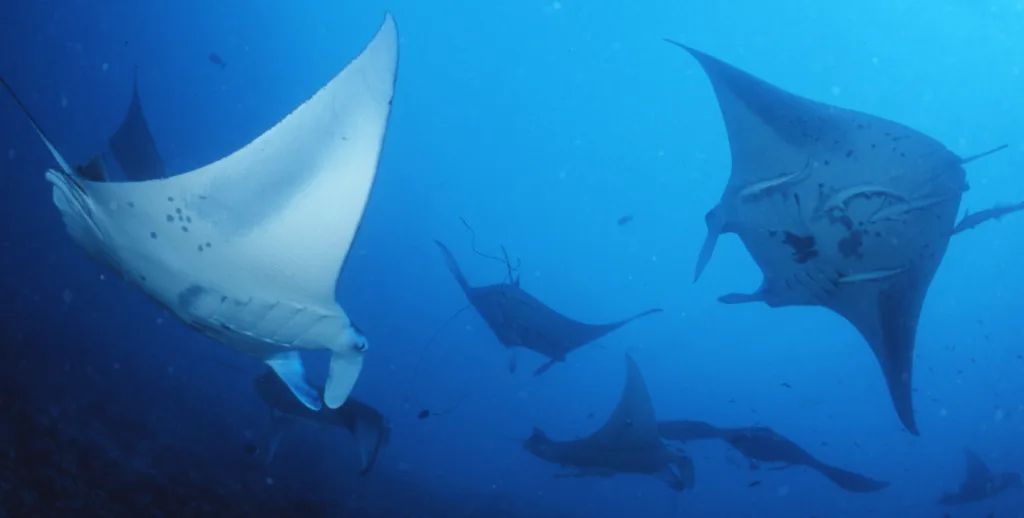
Best Liveaboards Visiting North Male Atoll
Live Boarding diving allows visitors to explore North Male Atoll’s calm and protected reef ecosystem and marine creatures. Scubaspa Yang and Carpe Novo are the best cruises.
How to Get To North Male Atoll
From Male International Airport, you can take a seaplane, speedboat, or ferry to get to North Male Atoll.
7. Raa Atoll
Raa Atoll, or Northern Maalhosmadulu Atoll, is a must visit place to see manta rays in the Maldives because of its untouched and unexplored reefs. It is separated from Baa Atoll by the Moresby Channel. Raa Atoll is 30 km wide and 70 km long. It is home to palm lined beaches, lagoons, underwater pinnacles, and two small inhabited islands, Alifushi and Iththigilli. The marine life in Raa Atoll consists of a large population of reef fish. In areas with strong currents, divers can enjoy meetups with manta rays and other pelagic species, along with colorful soft and hard corals. Sometimes, there are so many fish that you might lose sight of your diving partner.
Manta Season in Raa Atoll
You can go diving in Raa Atoll at any time of the year. Water temperatures usually range from 27 to 30 degrees Celsius. The peak manta season is from August to November.
Best Manta Ray Hotspots in Raa Atoll
Sola Corner
This popular diving site is located southwest of Raa Atoll in the Kukulkhudhoo channel. Sola Croner has a cleaning station about 15 meters deep where manta rays gather. Here, you can spot up to 7 to 8 mantas simultaneously.
Fenfushi Thila
This shallow underwater pinnacle has a wall, cliffs, and sloping reefs full of different fish types. In the summer, it is a popular site to see manta rays.
Other popular sites for manta ray sightings are Reethi Thila, Beriyan Kuda Thila, and Kottafaru.
Best Diving Resorts in Raa Atoll
With few inhabited islands and resorts, the accommodation options in Raa Atoll are very limited. Sadly, there are no resorts for budget conscious travelers. But in the future, they will be! Emerald Maldives Resort and Heritance Aarah are the high end options.
Best Liveaboards Visiting Raa Atoll
If you want to explore more dive sites, liveaboard diving is also available in Raa Atoll. Most of the liveaboard cruises visit Raa Atoll during the manta season. Princess Haseena and Carpe Novo are the best options.
How to Get To Raa Atoll
Raa Atoll is about 150 km from Male International Airport. From there, you can take a 30-minute domestic flight or a 45-minute seaplane.
8. Lhaviyani Atoll
Lhaviyani Atoll, also known as Faadhippolhu Atoll, is located in the northern Maldives. This horse shoe shaped atoll is the best place for manta ray encounters. It is home to over 50 coral islands and beautiful underwater formations, such as wrecks, reefs, walls, and overhangs. Its deep channels (kandus) attract reef manta rays, and submerged pinnacles (thilas) serve as cleaning stations for mantas.
The atoll has more than 50 diving sites. Beginners can dive in calm reefs, and advanced divers can explore deeper areas with strong currents. They have a greater chance of seeing manta rays. Drift diving is also an option in the atoll, with currents swinging you along corners and walls. Besides mantas, you’ll also see tuna, sharks, and collared butterflyfish.
Best Season to See Mantas
During the wet season, from May to November, there are higher chances of seeing manta rays. Divers can see these gentle giants feeding on plankton.
How to Get To Lhaviyani Atoll
Lhaviyani Atoll is accessible from Male Airport by a 3-40-minute seaplane flight. In Lhaviyani, you can travel between islands by dhoni or speedboat.
Manta Ray Hotspots in Lhaviyani Atoll
Fushivaru Thila
This protected marine park is famous for its reef manta ray population (adults and juveniles). During the southwest monsoon season, there are higher chances of manta rays being seen as they gather for feeding and cleaning.
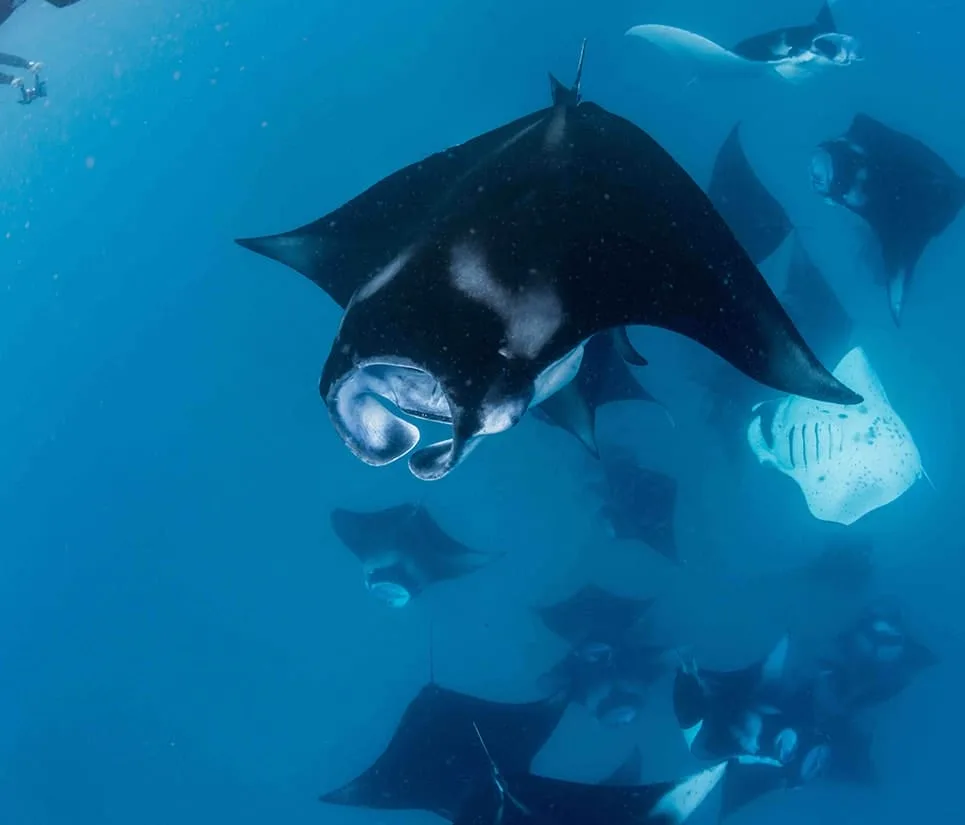
Felivaru Kandu
This big sandy channel is the best site for experienced divers to see manta rays in Maldives.
Kuredu Express
This dive site features strong currents and rich marine life, including manta rays and sharks. It is a must-visit site for experienced divers.
Best Diving Resorts in Lhaviyani Atoll
The atoll offers various accommodation options, such as Cocoon Maldives and Hurawalhi Island Resort. These resorts allow unlimited snorkeling and diving on their coral reefs.
Best Liveaboards Cruising Lhaviyani Atoll
For those visitors who want to explore most of the diving sites in one trip, many liveaboards go to the northern Maldives. Consider booking Amba Liveaboard, Princess Sara, and Blue Voyager.
9. Laamu Atoll
Laamu Atoll, or Hadhdhunmathi Atoll, offers a relaxing getaway away from busy atolls. It is one of the favorite atolls for travelers seeking manta rays in Maldives. The Maldivian Manta Ray Project (MMRP) has documented over 5,000 reef manta rays in the Maldives, and 138 rays were seen in Laamu Atoll. Its underwater formations include sunken coral islands and shoals on barrier reefs, surrounded by coral reefs and blue lagoons. The atoll has eight inhabited islands and over fifty uninhabited islands. The strong currents here draw manta rays, eagle rays, and sharks, making it one of the best places for scuba diving.
Best Time to See Mantas in Laamu Atoll
Laamu Atoll has a hot, sunny, and humid tropical climate with temperatures ranging from 25 to 30 degrees Celsius. Manta rays can be seen there all year round.
Manta Ray Spots in Laamu Atoll
Hithadhoo Corner
Located southeast of Laamu, this diving site is within the largest channel of the atoll. The strong currents in this region attract a large number of manta rays to its different cleaning stations.
Fushi Kando
This shallow 250-meter channel with five pinnacles attracts a large population of reef manta rays (adults and juveniles) to its cleaning stations. It is located on the northeast edge of Laamu Atoll between Maabaidhoo and Kandaru. You can see manta rays at the sandy bottoms of these pinnacles.
Best Diving Resorts in Laamu Atoll
Only a few hotels and resorts are located on the inhabited islands of Laamu Atoll, including Six Senses Laamu, Rahaa Resort, and Evexia Beach Collection Laamu.
Best Liveaboards Visiting Laamu Atoll
If you want to spend your entire trip on water, book a liveaboard cruise to explore most of the dive sites in Laamu Atoll. Soleil 2 and Emperor Leo are popular cruises.
How to Get to Laamu Atoll
The only way to reach Laamu Atoll is by taking a domestic flight from Male Airport to Kadhdhoo Airport on Laamu Island. The flight takes almost 45 minutes.
10. Fuvahmulah Atoll
Last but certainly not least! Fuvahmulah Atoll, nicknamed Shark Island, is one of the first places to see sharks and manta rays in the Maldives. Its remote location, deep channels, and large ocean currents create a unique natural ecosystem above and below the water. The atoll became a tourist destination in 2017 after shark diving.
MMCP has identified the largest number of oceanic manta rays in Fuvahmulah Atoll. In 2023, they reported 61 sightings of 55 individual oceanic manta rays.
From drifting dives in channels to beautiful coral gardens and encounters with pelagic species, the island offers endless adventures for visitors. Fubahmulah has over 20 dive sites, including Thoondu, Miskiy Reef, and Gazeera Thila. Although these dive sites are deep (5-30 meters) and have strong currents, free diving and snorkeling are the popular adventures here.
Manta Season in Fuvahmulah
Diving is an all around adventure in Fuvahmulah. For manta ray sightings, the best time to come is during the northeast monsoon, from February to April. The waters are calm, and visibility is maximum.
Manta Ray Hotspots in Fuvahmulah
Farikede
During the northeast monsoon, visitors can spot adult oceanic manta rays swimming through the reef at Farikede. They don’t stop here for feeding or cleaning!
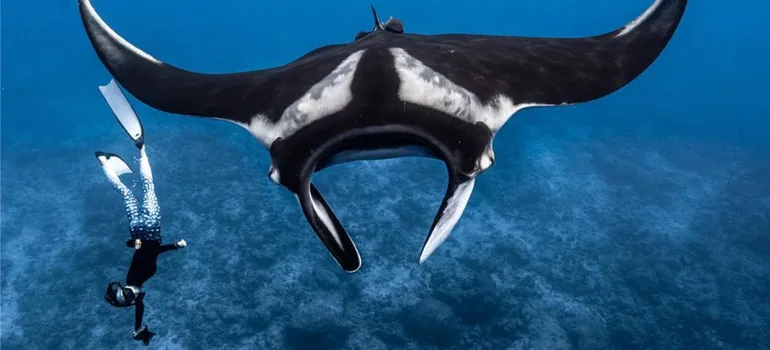
How to Reach Fuvahmulah
From Male, take a 1-hour domestic flight to Fuvahmulah Atoll. There are only two scheduled daily flights, so plan your journey accordingly. Another option to reach Fuvahmulah is from Gan International Airport in Addu Atoll.
Best Liveaboards Visiting Fuvahmulah Atoll
If you want to go on a liveaboard trip, Maldives has several cruises that offer itineraries through the deep south, including Fuvahmulah. Carpe Nova and Top Class Cruising-Sachika are the best ones.
Conclusion
There you go! I hope this blog post has helped you plan your manta ray adventure in Maldives. Manta rays are giant sea creatures with flat-diamond-shaped bodies. These acrobatic creatures display friendly behavior to divers and snorkelers with their graceful movements.
The Maldives have 26 atolls, most of which are natural habitats for manta rays. Two types of manta rays have been identified in the Maldives: oceanic manta rays and reef manta rays. MMCP has reported that Hanifaru Bay in Baa Atoll has the highest congregation of reef manta rays, and Fuvahmulah has seen the highest population of oceanic manta rays.
The best time to see manta rays in Maldives is the northeast monsoon, from December to April, and the southwest monsoon, from May to November. Some atolls, like Addu Atoll, South Ari Atoll, North Male Atoll, and Laamu Atoll, allow divers to see manta rays year-round.
So, if you want to increase your chances of seeing manta rays, plan your trip during the peak manta season.
Many certified tour operators organize manta ray sightings and diving and snorkeling experiences. Visitors who prefer watching these giant creatures from a boat can join a liveaboard trip.
Have you visited any of these atolls before or experienced diving with these gentle giants? Share your manta experiences in the comments below to inspire our readers! We can’t wait to hear about your adventure! Happy and safe travels!

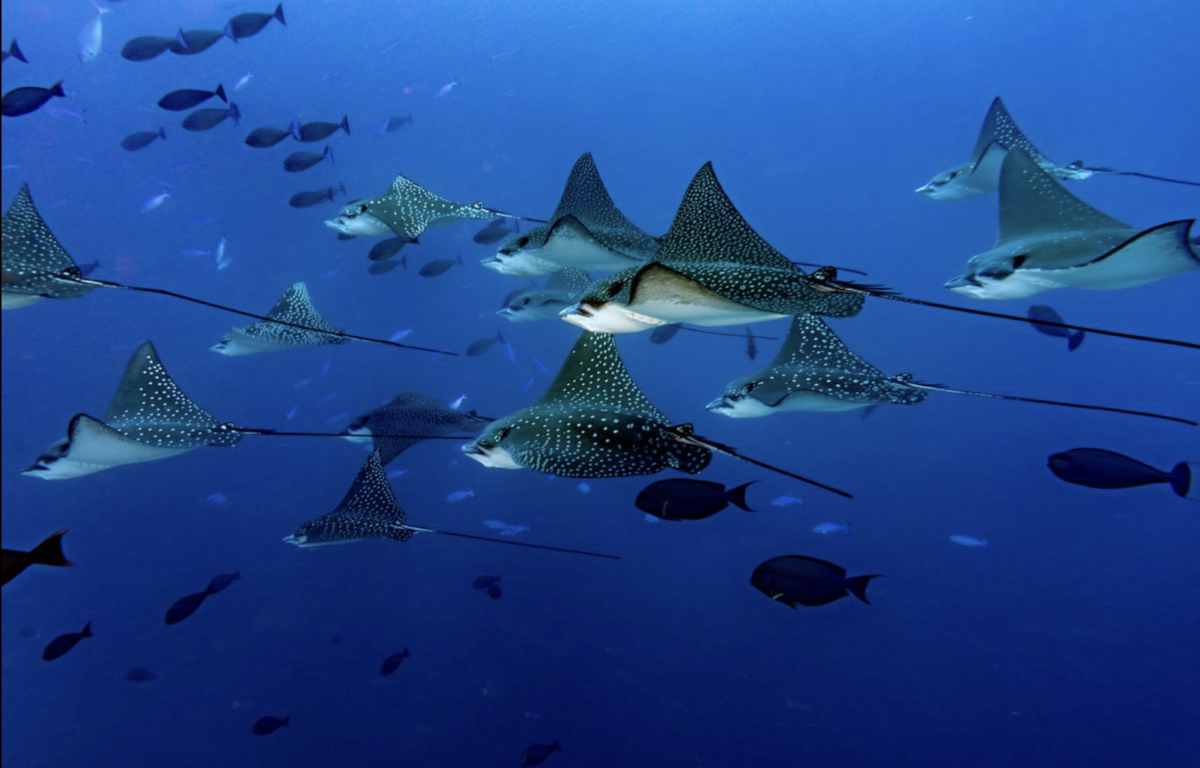
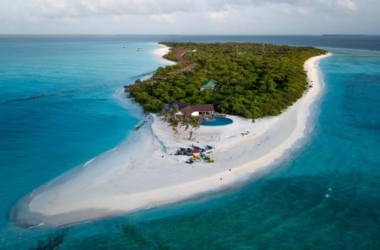



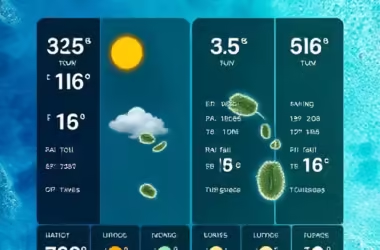






1 thought on “10 Best Places to See Manta Rays in Maldives: An Insider’s guide”
Comments are closed.